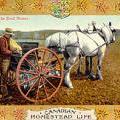 After the long Townships winter, spring was the time to do repairs and renovations on the farmhouse and outbuildings. Before the fields could be worked, there was a lot of work to be done. Re-shingling roofs; repairing or replacing chimneys and stone walls; and beginning work on any additions to the farm buildings were just a few of the tasks that occupied a farmer and his family in the spring.
After the long Townships winter, spring was the time to do repairs and renovations on the farmhouse and outbuildings. Before the fields could be worked, there was a lot of work to be done. Re-shingling roofs; repairing or replacing chimneys and stone walls; and beginning work on any additions to the farm buildings were just a few of the tasks that occupied a farmer and his family in the spring.
FENCES
As soon as the ground thawed, old fences had to be repaired and, in some cases, new ones built. Farm animals were usually turned out to pasture around the middle of May, so the fences had to be ready for them.
MANURE
The winter's accumulation of manure had to be taken by horse and wagon (or sled) to the fields. Manure was a valuable commodity because it was used as a fertilizer, and still is, to nourish the crops.
LUMBER
Many of the necessary building materials, such as lumber and shingles, were already on hand. The farmer's steady woodcutting during the winter months allowed him to save time and begin work as soon as the weather permitted. Craftsmen were sometimes hired for carpentry, stone or brick work, jobs requiring special skills and tools. Tarring roofs, painting, and whitewashing were common tasks that were done when the weather started to warm up in May.
VEGETABLES AND CROPS
Wheat, barley, oats, and hayseed were among the most common crops planted. The needs of each farm varied according to the number and type of livestock raised. The type of land that a farmer worked also influenced his choice of crops.
Vegetable gardens were planted around June to avoid the late frosts. The garden produced all of the family's vegetables. Any surplus could be sold. Potatoes were planted mid-May and were a basic part of the winter diet. They also stored very well in the cellar.